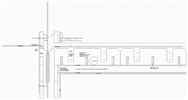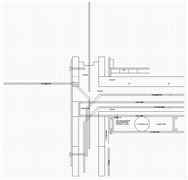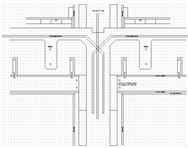Home Site Map - Techniques - Structure -
Carnation Flooring
![]() A
robust poured concrete floor forming system that strengthens
the overall building.
A
robust poured concrete floor forming system that strengthens
the overall building.
Form wet concrete into beams
The floors will be formed using poured in place concrete. To do this it is necessary to have something that will form the wet concrete into beams. Expanded polystyrene (EPS) can be cut to a shape that produces the forms for the beams. The EPS also stays permanently in place to provide sound insulation (and heat insulation) between floors.
Expanded polystyrene (EPS) is made as large ingots that are typically then cut up into sheets using a large computer controlled (CNC) hot wire cutting machine. If you feed that computer system with a suitable program it can, instead of cutting straight sheets, cut whatever profile you want. The ingots of manufactured EPS that the CNC hot wire machines take are typically just over 4 foot wide, 3 foot high, and 8 foot long.
Carnation Flooring is my own design of profile that I want the CNC hot wire cutting machine to cut to. The flooring EPS is 1 foot high, so I can get 3 sections of 4 foot wide 8 foot long flooring out of a 3 foot high ingot of EPS. The details of the cut dimensions can be seen in the cross section diagram below.
The floor is constructed by supporting the 8 foot long by 4 foot wide sections of polystyrene on lumber beams that fit into the smaller slots on the bottom. The beams (and the temporary props under the beams) are just to support the weight of the wet concrete and any construction workers. Once the concrete has set then it is the formed concrete beams that take the load. Rebar is laid in the beam cut outs prior to pouring concrete so the beams are fully strengthened.
The beams are made either using 2x12 lumber glued together to make beams that are at their widest 3" by 11" or you can use TJI-110 wooden I-Beams. Laminating a double layer of 2x12 lumber means they can be formed to any length without having to worry about what lengths of lumber are purchased (typically 2x12s are 16' long). The double layer is only actually needed for about 4' either side of the join. Where not near a join, the width can be padded from 1.5" to 3" using bits of 2x4 to keep the beams tight in place in the cut EPS. If using TJI-110 I-Beams then 3" wide 2-by strips are used on top to pad them out.
Even though the lumber is not structurally required after the concrete has set, it is good to keep the 2x12s (or TJI-110 wooden I-Beams) as they provide a good nailing surface for ceiling drywall. The 2x12s extend about 6" beneath the EPS and that forms a cavity for running pipes and wiring etc. Also even though the concrete floor will never fall, some people will find it comforting to know that there are also wooden beams holding up the floor.
As well as filling the big cutouts in the top of the EPS to form beams, the concrete also covers the whole floor area to a depth of 4" above the top of the EPS block. This forms a continuous concrete floor with integral concrete beams underneath it. As well as having rebar in the beams, there is also a lattice of rebar in the 4" floor concrete.
Cross Section

The cut-ins on the bottom are 3" wide and are to take up to two widths of 2-by lumber. The larger cut-ins at the top are 4" wide and form the concrete beams.
Where necessary, 90 degree corners are avoided so there are no sharp direction changes in the concrete that might introduce unnecessary stress in the concrete.
The overall block height is 12", so it possible to get three flooring sections (each 4' wide by 8' long) from a 3' high EPS ingot.
The beams formed are actually 14" high because the concrete goes 4" above the top of the EPS block.
The waste polystyrene that is cut out from the block are left in place when the cut EPS blocks are delivered and can be used for general insulation, eg in the house roof or round the foundations. The waste blocks for the concrete beam slots will be 10"x4"x8'. Just need to cut off the top corners with a craft knife. The waste blocks for the lumber beam slots are 5"x3"x8'.
Manufacturing
Most companies that manufacture EPS (in large computer controlled vacuum chambers) also have computer controlled hot wire cutting machines. All you need to do is come up with a control program in the right form for the particular make of CNC cutting machine. Typically the EPS company will have someone that can help translate your cross section diagram into the necessary control program for their cutting machine.
You will want to find an EPS manufacturing company that is geographically fairly close to you to avoid high transportation costs. In my case the company I chose was North West Foam that is in Twin Falls Idaho. There is also another company who is actually much closer, but their prices are slightly higher because they only sell via distributors.
North West Foam
2390 Rostron Circle Twin Falls, ID 83301
Ph. 208-734-7426 Fx.
208-736-8690
info@northwestfoam.com
I send them an AutoCAD drawing of the profile.
The EPS does not need to take much compression force, so would be ok to specify Type I EPS (Standard 1lb density with some regrind), but I prefer to use Type II.
Assembly and temporary floor bracing and support
The 2x12 beams go in the East-West direction. Their ends are supported by the internal walls and the west and east outer walls of the house. It's best to get nice straight lumber, but where there is a slight curve then the curves (the crowns) are arranged to be upwards.
The beams will be installed ahead of the EPS Carnation Flooring (and of course ahead of the concrete pour). The EPS Carnation Flooring will be fitted to the beams from above. Ahead of the concrete pour, the lumber beams will be supported by the 2x4 batons on the walls. There are of course also batons on the internal walls. Extra temporary support posts (made of 2x4) are used to stop the beams from sagging ahead of the concrete pour and while the concrete is setting.
To run pipes (up to 6") across the house (smallest dimension) you need to cut holes through the lumber beams (but that will be done after the concrete pour). Pipes (up to 6") in the other direction run underneath the EPS.
When using the Carnation Flooring system for decking and internal landings that do not have a wall to support it at the edge, then manually cut a beam form at 90 degrees to the pre-cut channels so that an additional beam is formed along the edge. It will need a wooden concrete form board along the outside to form the outer part of the concrete beam. Hand rail posts and landing balustrades will be attached to this concrete edge beam.
Other info
The ICF walls and the flooring above that story of walling is all done as one concrete pour. There is no concrete joint between the walls and the flooring - it all just flows together to form a monolithic unit. The rebar from the floors goes down into the walls and from the walls into the floor.
The flooring is also an ICF bracing system (for use before the concrete pour). The presence of the flooring helps stop the walls from tilting in or out and also holds the building square.
Connection To Side Wall
The following diagram shows how the flooring connects to the ICF walls at the side of the building (the short walls of the house rectangle).

Connection To Long Wall

Connection To Internal Wall




